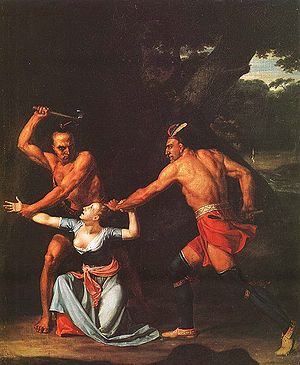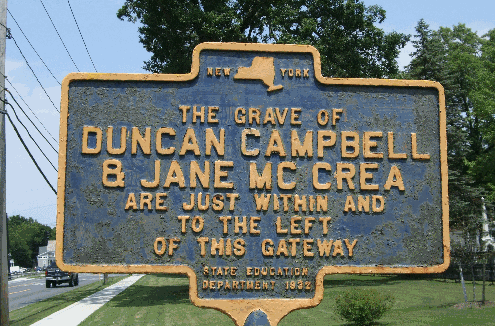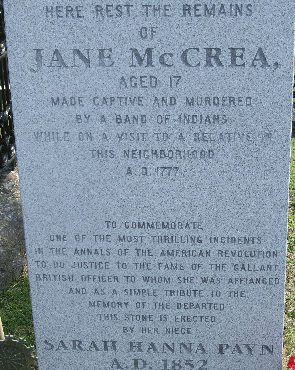
This painting by John Vanderlyn is a depiction of the murder of Jane McCrea on July 27, 1777.
If you stand at the entrance to the Washington County Building in Fort Edward and look across the street, you will see this sign.

If you then proceed through the gate and into the cemetary as the sign directs you, you will see the grave and tombstone of Jane McCrea. (I posted a full resolution picture if you click on the image below.)
This leads to the title of this post; who was Jane McCrea?
The sad irony is that Jane McCrea was a Loyalist murdered by Indians under the command of the British as she was going to see her British fiancé. It illustrates that in war sometimes it is unclear what side a person is on. Her death backfired on the British because it inspired the resistance to Burgoyne’s invasion leading to his defeat at Saratoga.
McCrae was born into the large family of Rev. James McCrae of New Jersey. Since her father’s death she had been living with her brother John near Saratoga and had become engaged to David Jones. When the war began two of her brothers joined the American forces while her fiancé fled with other Loyalists and joined the British army. Jones was serving as a lieutenant in one of the Loyalist militia units which was stationed at Fort Ticonderoga.
McCrea left her brother’s home and was traveling to join her fiancé at Ticonderoga. She had reached the village of Fort Edward. She was staying at the home of Sara McNeil, another Loyalist and an elderly cousin to the British General Simon Fraser.
On the morning of July 27, 1777, a group of Indians that were moving in advance of the main British force on their way to Saratoga, descended on the village of Fort Edward. They massacred a settler and his family, and then killed Lieutenant Tobias Van Vechten and four others when they walked into an ambush.
This same company of Indians then also raided the McNeil house, taking Jane and Mrs. McNeil hostage. As they withdrew, the two women were separated and Jane was murdered.
There are conflicting accounts of her death. The traditional version has it that two warriors quarreled over who would take her in for an expected reward thinking she was on the side of the Americans, and that one of them killed her with a tomahawk to settle the issue. Another account is that she was killed by a bullet from the Americans withdrawing from Fort Edward. This second version was claimed by the warrior who had her scalp, presumably to avoid punishment when questioned by General Fraser.
When Burgoyne heard of the killing he went to the Indian camp and ordered the culprit to be delivered, threatening to have him executed. He was told by General Fraser that such an act would cause the defection of all the Indians and might cause them to take revenge on the Britsih as they went back north. Burgoyne relented, and no action was taken against the Indians.
News of Jane’s death traveled quickly and became exaggerated and incited American resistance because of her horrible murder.
In the end the murder of Jane McCrea was a historical turning point in the Revolutionary War because it turned public opinion further against the British.
So the next time you’re at the Washington County Center in Fort Edward, venture across the road and pay your respect to the young lady buried there.
(The above was condensed from online sources.)

